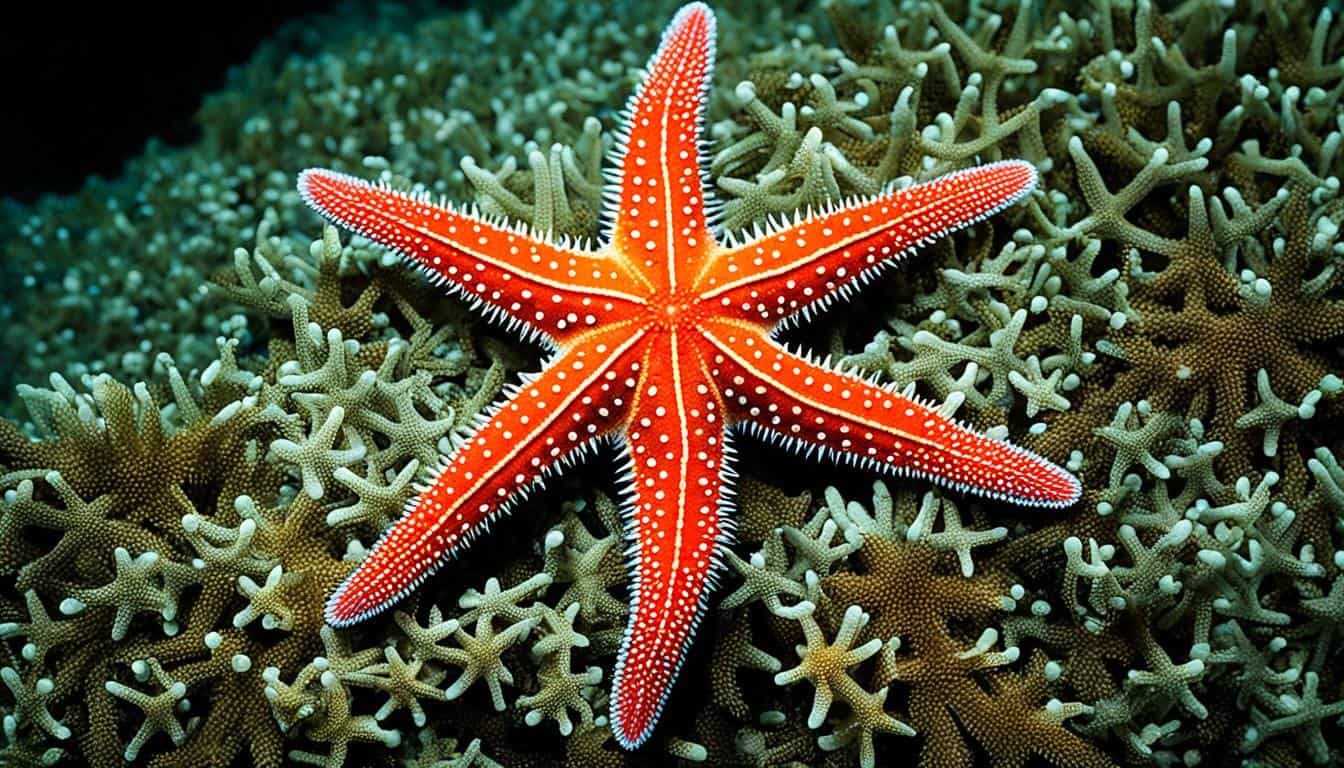Starfish, also known as sea stars, are vital to the ocean’s balance. With about 1,500 to 2,000 species, you might ask, how do they stay safe from predators? These echinoderms have many ways to defend themselves against threats like fish, crabs, and other enemies. Learning about their defense strategies helps us understand their role in the ocean and how they survive.
Introduction to Starfish Defense Mechanisms
Starfish have many ways to keep safe from their enemies. They use both physical and chemical defenses. These strategies help them in different environments and against different predators. Learning about these defenses shows how adaptable starfish are in the ocean.
Starfish have complex neural systems, even without a central brain. This lets them react fast to threats. They move slowly, but they can still avoid danger. Many starfish have spines and tough skin to keep predators away. These features make it hard for predators to eat them.
Chemical defenses are also key to their survival. Some starfish make toxic compounds that keep predators away. This adds another way for them to stay safe.
Each starfish species has its own way of defending itself, based on where it lives and the predators it faces. This shows how diverse and complex starfish defenses can be in different parts of the ocean.
| Defense Mechanism | Description |
|---|---|
| Physical Features | Spines and tough skin provide a protective barrier against predators. |
| Chemical Defenses | Toxic substances deter natural enemies from consuming starfish. |
| Neural Response | Complex neural systems allow for quick reactions to threats despite the absence of a central brain. |
| Species Adaptation | Defense mechanisms are tailored according to habitat and predation pressures. |
Predators of Starfish
Learning about the threats starfish face helps us understand how they survive. The natural enemies of starfish include many species, with fish leading the charge. Fish like triggerfish and pufferfish actively hunt them. Crabs, especially the green crab, target starfish during low tide. Even other starfish can be a threat, especially when competing for resources.
The impact of these starfish predator dynamics is huge. These interactions shape how starfish behave and affect their numbers in the ocean. Starfish must adapt to survive due to changing conditions and the number of predators. This leads to the development of unique defense strategies, making it a fascinating topic in marine biology.
| Predator Type | Examples | Impact on Starfish Populations |
|---|---|---|
| Fish | Triggerfish, Pufferfish | High predation rates contribute to population control |
| Crustaceans | Green Crab, Hermit Crab | Predation during low tide affects starfish availability |
| Other Echinoderms | Sea Stars | Inter-specific competition can lead to cannibalism in confined spaces |
How do starfish protect themselves from predators?
Starfish have many ways to avoid being eaten. They use chemical defenses as a key part of their survival. These chemicals help them stay safe by keeping predators away.
Introduction to Chemical Defenses
Starfish have special compounds like saponins and tetrodotoxins for defense. Saponins make them taste bad, so predators don’t want to eat them. These compounds can cause nausea and vomiting in predators, stopping them from coming back.
Use of Saponins and Tetrodotoxins
Some starfish also make tetrodotoxins. For instance, Astropecten polyacanthus has this toxin. It’s very dangerous for animals that try to eat these starfish. This shows how starfish have evolved to stay safe in their homes.
| Defense Mechanism | Example Compound | Effect |
|---|---|---|
| Saponins | Glycosides | Causes nausea and vomiting in predators |
| Tetrodotoxins | Neurotoxin | Potentially lethal to predators |
Learning about these defenses shows how starfish have adapted to stay safe. They use chemicals to keep predators away. This helps them live in their ocean homes.
Physical Defense Mechanisms: Armor and Spines
Starfish are tough because of their special physical defenses. Many have hard skin that turns into a shield called starfish armor. This armor stops predators from easily eating them. It’s not just for protection; it also helps them keep water in, which is key to their survival.
Starfish spines are another big part of their defense. These sharp points hurt predators, making them think twice before attacking. These spines show how starfish have adapted over time to stay safe in the ocean.
Starfish use their tough skin and spines to stay alive. These features help them live in different ocean areas and avoid being eaten. Their defense strategy is smart and effective.
Camouflage and Burial as Survival Tactics
Starfish have amazing ways to stay safe from dangers. They use starfish camouflage and burial to avoid predators. These methods help them blend in and hide, keeping them safe.
The Role of Sediment in Concealment
Starfish dig into sand or mud to hide, which helps them avoid predators. This makes them hard to see and keeps them safe. Species in the order Paxillosida are great at this, using the ground to hide and find food too.
Starfish can change how they look to match their surroundings. This shows how well they adapt and survive in different ocean places. By fitting in, they can avoid being caught and stay alive.
| Survival Tactics | Description |
|---|---|
| Starfish Camouflage | Blending in with the environment to avoid predators. |
| Burial Strategies | Digging into sediment to conceal themselves from threats. |
| Predator Avoidance | Utilizing camouflage and burial techniques to escape detection. |
These tactics show how clever and resourceful starfish are at avoiding dangers in their homes.
Regeneration: A Unique Survival Strategy
Starfish show us how amazing marine life can be, especially their skill to regrow lost limbs. This starfish regeneration is more than just a way to survive. It’s a key trait that helps them live well despite being hunted a lot.
Autotomy: Shedding Limbs to Escape
Some starfish have a special way to get away from danger called autotomy. They choose to lose a limb to distract predators. This lets the rest of their body escape safely. The lost limb can grow back, thanks to their amazing ability to regenerate.
How fast and well they can regrow depends on the starfish type. Here’s what you need to know about starfish regeneration:
| Aspect | Description |
|---|---|
| Regeneration Time | It can take weeks to months, based on the species and the environment. |
| Energy Cost | Regrowing limbs uses a lot of energy, which can affect their health. |
| Functional Recovery | Regrown limbs might not work as well as the original ones at first. |
| Frequency of Autotomy | Some species do this more often, depending on their home and the dangers they face. |

The power of starfish regeneration shows how tough these sea creatures are. Learning about their ways to escape teaches us about their survival skills. It also helps us see how complex marine life can be.
Behavioral Strategies for Predator Evasion
Starfish have amazing ways to stay safe in places full of predators. They use smart ways to avoid being caught, like moving slowly. This helps them not get noticed by predators.
They also hide under rocks or in small spaces. This keeps them safe from danger. It shows they know how to use their environment to stay safe.
Starfish can also use special chemicals to protect themselves. When they feel threatened, they release these chemicals. This adds another way for them to stay safe in the ocean.
The Importance of Conservation for Starfish Populations
Starfish face big challenges in their homes due to pollution, overfishing, and losing their habitats. These threats lead to a big drop in their numbers in many places. By understanding their struggles, we can help protect them and keep our oceans healthy.
Starfish are key to keeping the ocean in balance. They eat certain animals, which helps keep their numbers in check. We need to protect them so they can keep doing their job in the ocean.
It’s up to us to care about starfish and help them survive. By joining local conservation efforts and living eco-friendly, we make a difference. Together, we can fight the threats to starfish and keep them in our oceans for the future.
FAQ
How do starfish protect themselves from predators?
Starfish use many ways to stay safe, like chemicals, hard skin, and sharp spines. They also move slowly and hide in tight spots.
What are the common predators of starfish?
Fish, crabs, and other starfish often eat starfish. They are easy targets because they move slowly and are not always alert.
What role do chemical defenses play in starfish survival?
Starfish have chemicals like saponins that make predators feel sick. Some starfish can also be very toxic, keeping predators away.
How does the physical structure of starfish serve as a defense?
Starfish have hard skin and sharp spines. These protect them from predators by causing pain and discomfort.
What camouflage techniques do starfish use to avoid predators?
Some starfish can hide in sand or mud. This makes them hard to see, helping them avoid being eaten.
Can starfish regenerate lost limbs as a way to escape predators?
Yes, some starfish can cut off a limb to escape danger. They can grow back new limbs over time.
What behavioral strategies do starfish employ to evade predators?
Starfish move slowly and hide under rocks or in tight spots. They also use chemicals to defend themselves when needed.
Why is conservation important for starfish populations?
Conservation is key because starfish face dangers like pollution, losing their homes, and being taken too much. Keeping starfish safe helps the ocean’s balance.







